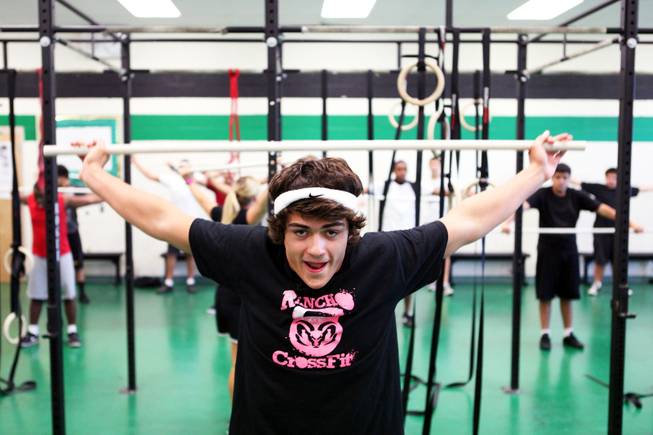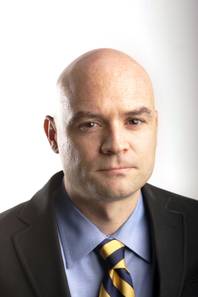
Senior Abel Gomez, 17, stretches his shoulders during CrossFit gym class at Rancho High School in Las Vegas on Wednesday, September 12, 2012.
Saturday, Sept. 15, 2012 | 2 a.m.
View more of the Sun's opinion section

J. Patrick Coolican
Sun coverage
When I was in school, gym class was a bit of a joke, and I’m sure the same is true for you. The kids who were athletic and competitive would play flag football or basketball while everyone else stood around and sullenly watched. The kicker was that in middle school, my gym teacher was morbidly obese.
And then there’s Michelle Van Buren.
She’s a physical education teacher and the varsity softball coach at Rancho High School who wants to make gym class a rigorous experience, one that will lead to weight loss, muscle gain, better flexibility, mental agility and toughness.
Van Buren has introduced a program called CrossFit to Rancho. You may have heard of CrossFit — the CrossFit Games started this month on ESPN2. It’s a full-body workout that mixes strength, cardio and flexibility and is designed to suit anyone, be it an athlete, a homemaker or a high school student. The affiliate CrossFit gyms — sort of like franchises but with more independence — emphasize healthy communities, which is how this workout regimen wound up at Rancho High.
Van Buren started training two and a half years ago with Jared Glover, a young UNR grad and entrepreneur whose expanded CrossFit 702 opens this month in the northwest valley.
“I was hooked, and I thought, ‘How can I bring this to the kids?’” Van Buren told me. She did, after becoming a nonprofit affiliate of CrossFit.
Last year, she taught one CrossFit class. The students, athletic director and football coach loved it, and this year, she’s added more.
About 35 kids file into the CrossFit room — a former weight room that has kettlebells, weights, PVC pipe for stretching, foam rollers and a rack that looks like a jungle gym for adults.
Van Buren tells them their workout. Stretching and a 200-meter run to warm up. Then they’ll use a 15-, 30- or 45-pound bar to do 10 shoulder presses, followed by one “burpee,” which is when you start in a standing position, drop to the ground, allowing your chest to touch the floor, then jumping back up, even leaping into the air, with hands held high. Then they’ll do nine shoulder presses and two burpees, then eight shoulder presses and three burpees, continuing in that pattern until they do one shoulder press and 10 burpees. This early in the school year, Van Buren wants them to hone their technique.
“Encourage one another,” Van Buren says just before they begin. This is another part of CrossFit — athletes think of themselves as teammates.
Omar Garcia is 16 and a junior who doesn’t play high school sports. But he is a star pupil in this class. He was in the class last year, and he says it was transformative. “Waking up sore after the first hard day of class, I decided I love this class,” he said. He believes he lost 20 pounds of fat and replaced it with nearly that in muscle.
Varsity wrestler Abel Gomez, 17 and a senior, says the program offers nice parallels to wrestling, including the full-body workout, endurance, mental toughness and commitment. His T-shirt reads, “My warmup is your workout.”
Van Buren is a CrossFit evangelist, believing the skills she’s teaching will allow her students to pursue fitness for the rest of their lives. She says surveys she gave at the end of last year indicated her students felt better about themselves, slept better and had more energy.
The only downside? At the moment, CrossFit is only an elective class. It should be a requirement.
As The New York Times reported last year, there are loads of new evidence that physical activity improves intellectual performance and brain health.
As Van Buren notes of the average sedentary teenager, “If you’re sluggish and tired, how well will you do in math?”
And although it may be unfair, the simple fact is employers tend to discriminate against obese applicants and workers. Many Rancho High School students are dealing with enough disadvantages as is and don’t need another, which makes fitness all the more important.
Finally, recent research indicates health habits, such as eating, exercise and smoking, are contagious, so your behavior influences the behavior of your friends and relatives, from one social network to another.
In other words, healthier Rancho High School students could improve the health habits of entire neighborhoods and, by extension, the rest of us.
There’s a movement afoot, both here and nationally, to improve academic achievement.
Why shouldn’t rigorous physical fitness go hand-in-hand with that goal?


Join the Discussion:
Check this out for a full explanation of our conversion to the LiveFyre commenting system and instructions on how to sign up for an account.
Full comments policy